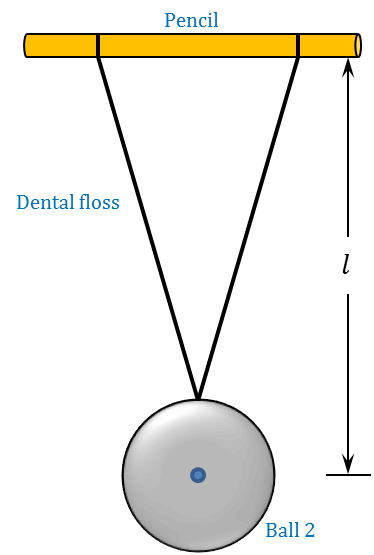
The basic idea is to charge two styrofoam balls with similar charges and determine the repulsive electric forces ($F_e$) when the balls are at different distances ($r$) from each other. For the purpose of data collection, you will need a digital camera with reasonable resolution. The built-in camera in modern smartphones should be suitable for this purpose. A personal (desktop or laptop) computer is also necessary for data analysis and for the preparation of the lab report.
Before you start, carefully review all the steps involved in performing the experiment and make sure you have all required items. When you are ready, assemble your setup and run the experiment as specified below. Take multiple pictures at different stages of your experiment. The pictures should be clear and sufficient in number to show the procedure.
Note: Some students find it difficult to maintain charges on the Styrofoam balls long enough to collect experimental data. A possible cause of this problem is high humidity, which accelerates charge leakage. Do your best to do the experiment on less humid days and avoid locations (in the house) with excessive humidity like the kitchen. If you attempt this experiment more than once without success, contact your tutor and provide clear pictures of your setup. Your tutor will assess the situation and may decide to send you pre-collected data for analysis.
Please perform proper risk assessment and do not pursue any project whose procedure, equipment, or material poses any safety issues. Do not attempt an experiment that might cause any type of harm or injury to yourself or others. Remember that safety comes first.

The experiment involves hanging one of the styrofoam balls from a pencil using two dental floss strings (about 35 cm each), as shown in Figure 1.1. To increase the stability of the ball during the experiment, the upper ends of the strings should be kept a few centimetres apart when tied to the supporting pencil. The lower ends should be attached to the same point on ball's surface using a small piece of tape. When suspended, the ball should be hanging about $30\,\text{cm}$ below the pencil. Make sure the system is properly and securely supported as seen in Picture. It is also important to avoid doing the experiment near sources of air steams, such as open doors, windows, fans, or heating vents.
When the ball is hanging vertically, place a small sticker or any visible mark on the wall behind the lower ends of the strings. The sticker/mark acts as a point of reference to indicate the origin of the coordinate system as shown in Picture. Support your camera about one metre away from the wall, focusing on the styrofoam ball (see Picture). Make sure that the position and orientation of the camera does not change during the experiment. Take a picture of the vertically hanging ball before moving to the next step.
Insert a sharpened pencil halfway through the other styrofoam ball. Mount the pencil and use tape to fix it on a suitable support that can be easily moved horizontally, from left to right. Adjust the position of the two balls to be at the same elevation. The next step is to place excess charge on each ball by rubbing it with a piece of cloth, preferably wool or cotton. As a result, the two balls will carry similar charges, generating a repulsive electric force between them.
Place the movable ball (Ball 1) about $20\,\text{cm}$ to left of the hanging ball. This should cause the ball-string system to displace away from the vertical position (see Picture). Take a picture of the setup while in this position. Move Ball 1 about one centimetre closer to the hanging ball. If the hanging ball makes small oscillations, wait few seconds and allow it to stabilize before taking a picture. Keep advancing Ball 1 towards the hanging ball, taking a picture after each step, until it loses balance or the two balls nearly touch each other. You should take between ten and twenty pictures for different ball separations. If the hanging ball falls prematurely, repeat the experiment.
Transfer the pictures to a properly labeled folder on your computer. Do not forget to record the value of $l$, which is the distance from the string support to the centre of the ball (see Figure 1.1). Also, locate and record the information concerning the mass and diameter of the styrofoam balls, which should be included in the lab kit.
➤ Analysis